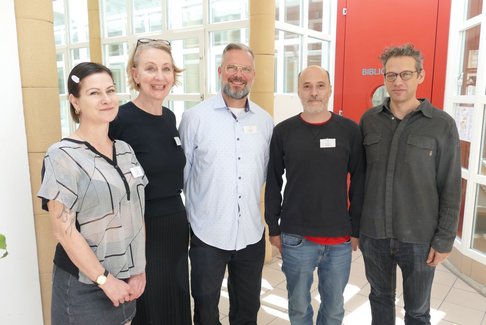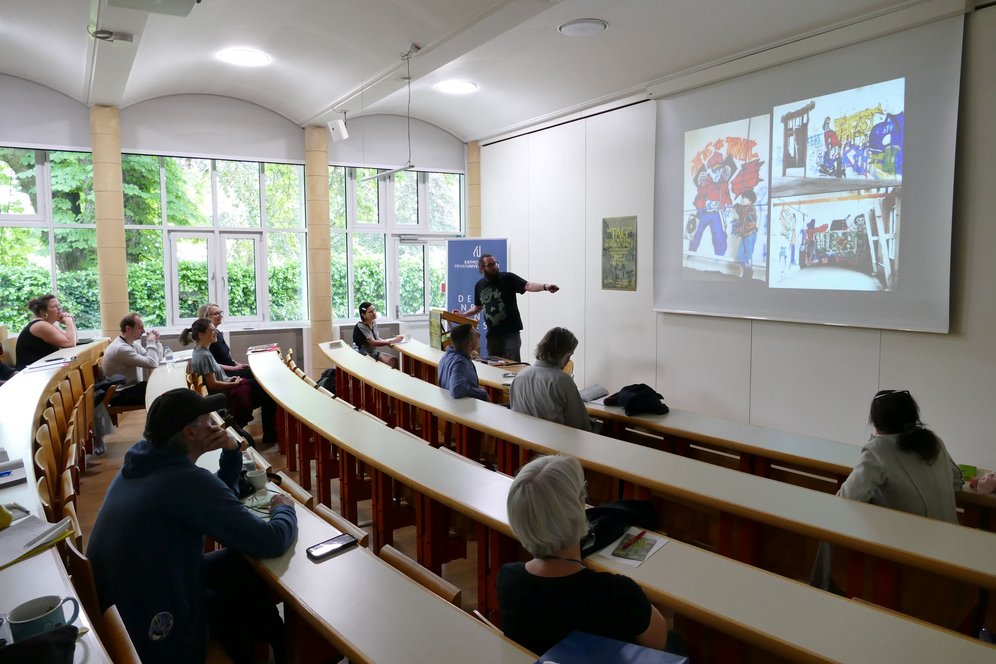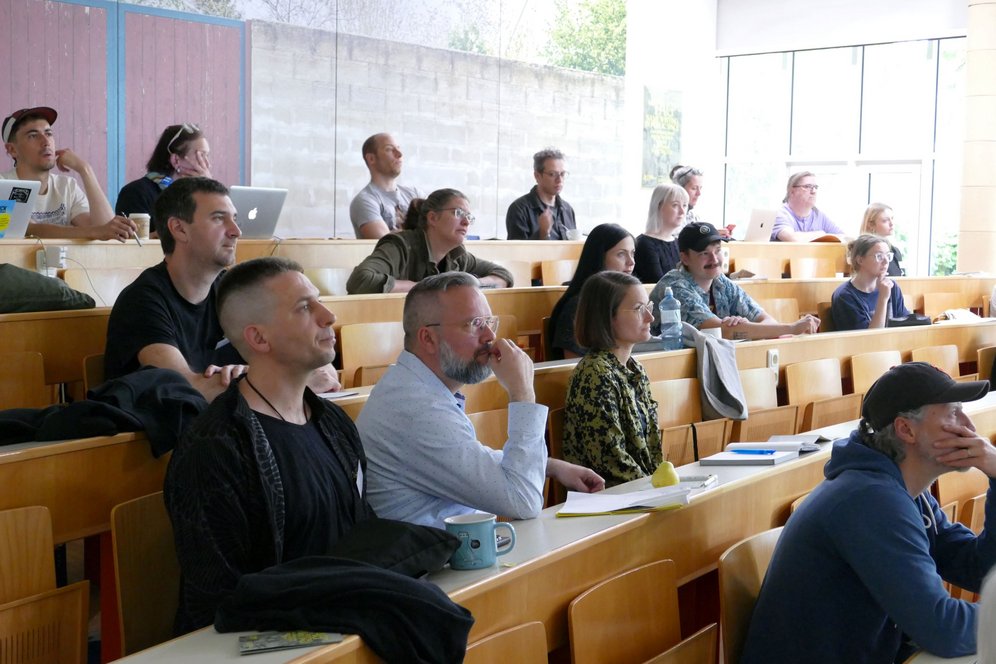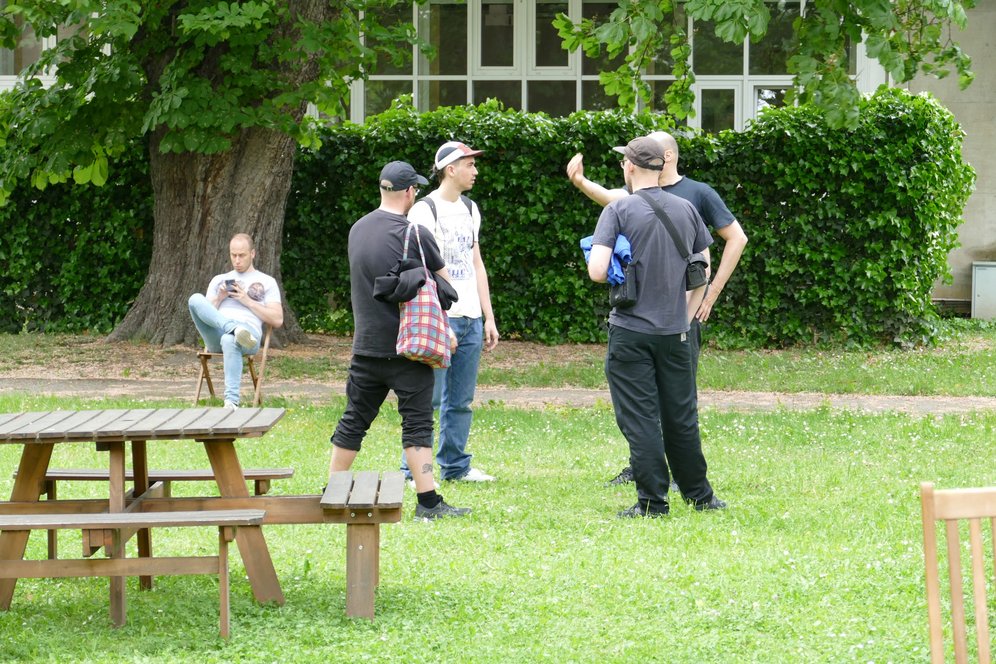Internationale TAG Conference: Namen schreiben im öffentlichen Raum.

Ergänzt wurde die Tag Conference durch die Unlock Book Fair, welche die Avantgarde der unabhängigen Graffiti-Publikationen aus aller Welt zusammenbringt. Die am Wochenende nach der Konferenz in München stattfindende Unlock bot den Teilnehmer:innen die Möglichkeit, nahtlos ihre Erkundung der Graffiti-Kultur fortzusetzen.
Ein wiederkehrendes Thema der Konferenz waren die Tags von Joseph Kyselak. Kyselak, ein österreichischer Beamter, wurde unerwartet zu einer Legende in der Graffiti Welt, nachdem er im frühen 19. Jahrhundert seinen Namen an unterschiedlichen Orten im Alpenraum hinterlassen hatte. Seine Wanderungen, 1828 in einer umfangreichen Schrift publiziert, inspirieren Graffiti-Enthusiasten und Wissenschaftler:innen gleichermaßen. Das Konferenzposter zeigte treffend ein Detail aus einer Lithografie von der Donaualände in Linz aus dem Jahr 1840, auf der ein Graffiti Kyselaks zu sehen ist.
Das Konferenzprogramm war so vielfältig wie umfassend. Die Sektionen deckten ein breites Themenspektrum ab, von der Renaissance-Ära des ersten Archäologen Antonio Bosio, vorgestellt von Egidio Emiliano Bianco, über 500 Jahre alte Schul-Graffiti im Kloster Maulbronn, präsentiert von Julian Windisch, bis hin zu zeitgenössischen Formen des Graffiti in China, untersucht von Marta R. Bisceglia und Adriana Iezzi. Andere Beiträge beleuchteten oft übersehene Kapitel der europäischen Geschichte, wie in Tobias Barenthins Vortrag über Graffiti in Stockholm in den 1980er Jahren, untersuchten eingeritzte Namen von Touristen in Ägypten um 1800, vorgestellt durch Hania El Hourys, und analysierten die Schnittstellen von tag-inspirierter zeitgenössischer Kunst, der ein ganzes Panel mit den Künstlern Rich Keville, Benjamin Rubloff und Tofa gewidmet war.
Ein besonderer Schwerpunkt lag auf dem Graffiti-Erbe Österreichs, das seine Entwicklung von Kyselaks wegweisenden Tags, erläutert in dem Beitrag von Gabriele Goffriller, bis hin zu modernen Ausdrucksformen, illustriert durch die Untersuchungen von Pablo Summer sowie Stefan Wogrin, nachzeichnete. Ein gelungener Abschluss bildete diesbezüglich auch die geführte Tour durch Linz mit Sabine Sinzinger. Dieser Fokus unterstrich das Engagement der Konferenz, historische und zeitgenössische Graffiti-Praktiken zu verbinden und ein ganzheitliches Verständnis dieses lebendigen kulturellen Phänomens zu fördern.
Die Tag Conference 2024 befasste sich auch mit der sich wandelnden Wahrnehmung von Graffiti, hervorgehoben durch die Präsentationen der Mitglieder des wissenschaftlichen Beirats Javier Abarca, Orestis Pangalos und Edward Birzin. Während zeitgenössische Tags oft an den Rand gedrängt werden, stellte die Konferenz sie als grundlegende Elemente der Graffiti-Kultur dar. Durch die Zusammenführung von Wissenschaftler:innen verschiedener Disziplinen zeigte die Veranstaltung erneut, die Bedeutung des Tagging innerhalb des breiteren Forschungsfeldes auf.
Die diesjährige Konferenz bekräftigte das Ziel, einen Raum zu schaffen, in dem historische und zeitgenössische Graffiti gleichermaßen studiert und geschätzt werden können. Als die Teilnehmer:innen Linz verließen, nahmen sie ein tieferes Verständnis für die reiche Geschichte des Graffiti und dessen fortlaufende Entwicklung mit.
24.5.2024/Ilaria Hoppe/HE
TAG: Name Writing in Public Space. A Conference about Tagging, in History and Today
The historic city of Linz recently played host to the Tag Conference, a premier event in the field of graffiti studies. Held at the Institute for Contemporary Arts and Media under the direction of Ilaria Hoppe at the Catholic Private University of Linz, the conference brought together scholars and researchers from America, Australia, and Europe to explore the art and history of tagging.
The Tag Conference, now in its seventh year, has firmly established itself as a cornerstone event in graffiti studies, with previous editions held in major cities like New York and Hamburg. This year's gathering, set against the picturesque backdrop of Linz, offered a unique platform for delving into the multifaceted world of graffiti. Complementing the Tag Conference was the Unlock Book Fair, a must-attend event for graffiti book lovers. Held in Munich over the weekend following the conference, Unlock offered attendees a seamless transition to continue their exploration of graffiti culture. The fair featured a dynamic program of talks, screenings, and book launches, showcasing the cutting edge of independent graffiti publishing from around the world.
A recurring topic at this Tag Conference were the tags of Joseph Kyselak. Kyselak, an Austrian civil servant, became an unexpected tagging legend after inscribing his name across various European landmarks in the early 19th century. His exploits, immortalized in his 1828 publication, continue to inspire graffiti enthusiasts and scholars alike. The conference poster aptly featured a detail from an 1840 lithograph of Linz where a tag by Kyselak is reproduced on a wall, celebrating his historical contributions.
The conference program was as diverse as it was comprehensive. Sessions covered a wide array of topics, from the Renaissance-era marks of Antonio Bosio, presented by Egidio Emiliano Bianco, or 500 years of school graffiti found in the Maulbronn monastery, showcased by Julian Windisch, to contemporary graffiti letterforms in China, examined in the research of Marta R. Bisceglia and Adriana Iezzi. Discussions explored often overlooked chapters of European tagging history from the 1980s, as presented by Tobias Barenthin in his talk about Stockholm graffiti, examined carved names left by Romantic-era tourists on monuments in Egypt, introduced through Hania El Houry’s presentation, and analyzed the intersections of tag-inspired contemporary art, covered in a panel with artists Rich Keville, Benjamin Rubloff and Tofa.
A special emphasis was placed on Austria’s graffiti heritage, tracing its evolution from Kyselak’s pioneering tags, in the paper by Gabriele Goffriller, to modern-day expressions of writing, illustrated by the investigations by Pablo Summer as well as Stefan Wogrin, and furthermore trough the guided tour in Linz with Sabine Sinzinger. This focus underscored the conference’s commitment to bridging historical and contemporary graffiti practices, fostering a holistic understanding of this vibrant cultural phenomenon.
The Tag Conference 2024 also addressed the evolving perception of graffiti, underscored by the presentations of the members of the scientific committee Javier Abarca, Orestis Pangalos and Edward Birzin. While contemporary tags are often marginalized, the conference positioned them as fundamental elements of graffiti culture. By bringing together scholars from different eras and disciplines, the event sought to elevate the study of tagging and affirm its significance within the broader scope of graffiti research.
This year’s conference reaffirmed the Tag Conference’s mission to create a space where historical and contemporary graffiti can be studied and appreciated on equal terms. As the attendees departed from Linz, they left with a deeper understanding of graffiti’s rich history and its ongoing dialogue and evolution.
24.5.2024/Ilaria Hoppe




